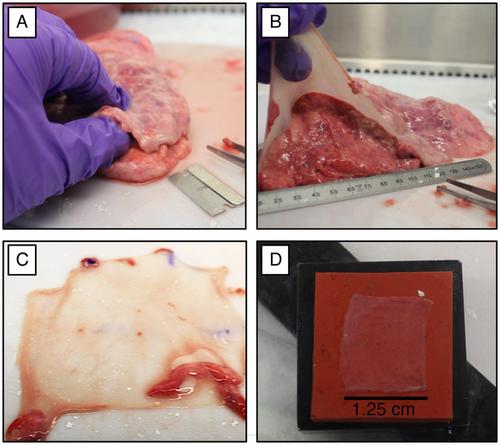{"title":"Lung Mechanics: Material Characterization of Pulmonary Constituents for an Experimentally Informed Computational Pipeline","authors":"Talyah M. Nelson, Crystal A. Mariano, Gustavo O. Ramirez, Arif Badrou, Kathrine A. M. Quiros, Matthew Shankel, Mona Eskandari","doi":"10.1002/cpz1.70001","DOIUrl":null,"url":null,"abstract":"<p>The lung comprises multiple components including the parenchyma, airways, and visceral pleura, where each constituent displays specific material properties that together govern the whole organ's properties. The structural and mechanical complexity of the lung has historically undermined its comprehensive characterization, especially compared to other biological organs, such as the heart or bones. This knowledge void is particularly remarkable when considering that pulmonary disease is one of the leading causes of morbidity and mortality across the globe. Establishing the mechanical properties of the lung is central to formulating a baseline understanding of its operation, which can facilitate investigations of diseased states and how the lung will potentially respond to clinical interventions. Here, we present established and widely accepted experimental protocols for pulmonary material quantification, specifying how to extract, prepare, and test each type of lung constituent under planar biaxial tensile loading to investigate the mechanical properties, such as physiological stress–strain profiles, anisotropy, and viscoelasticity. These methods are presented across an array of commonly studied species (murine, rat, and porcine). Additionally, we highlight how such material properties may inform the construction of an inverse finite element model, which is central to implementing predictive computational tools for accurate disease diagnostics and optimized medical treatments. These presented methodologies are aimed at supporting research advancements in the field of pulmonary biomechanics and to help inaugurate future novel studies. © 2024 The Author(s). Current Protocols published by Wiley Periodicals LLC.</p><p><b>Basic Protocol 1</b>: General procedures in lung biaxial testing</p><p><b>Alternate Protocol 1</b>: Parenchymal-specific preparation and loading procedures</p><p><b>Alternate Protocol 2</b>: Airway-specific preparation and loading procedures</p><p><b>Alternate Protocol 3</b>: Visceral pleura–specific preparation and loading procedures</p><p><b>Basic Protocol 2</b>: Computational analysis</p>","PeriodicalId":93970,"journal":{"name":"Current protocols","volume":"4 9","pages":""},"PeriodicalIF":0.0000,"publicationDate":"2024-09-06","publicationTypes":"Journal Article","fieldsOfStudy":null,"isOpenAccess":false,"openAccessPdf":"https://onlinelibrary.wiley.com/doi/epdf/10.1002/cpz1.70001","citationCount":"0","resultStr":null,"platform":"Semanticscholar","paperid":null,"PeriodicalName":"Current protocols","FirstCategoryId":"1085","ListUrlMain":"https://onlinelibrary.wiley.com/doi/10.1002/cpz1.70001","RegionNum":0,"RegionCategory":null,"ArticlePicture":[],"TitleCN":null,"AbstractTextCN":null,"PMCID":null,"EPubDate":"","PubModel":"","JCR":"","JCRName":"","Score":null,"Total":0}
引用次数: 0
Abstract
The lung comprises multiple components including the parenchyma, airways, and visceral pleura, where each constituent displays specific material properties that together govern the whole organ's properties. The structural and mechanical complexity of the lung has historically undermined its comprehensive characterization, especially compared to other biological organs, such as the heart or bones. This knowledge void is particularly remarkable when considering that pulmonary disease is one of the leading causes of morbidity and mortality across the globe. Establishing the mechanical properties of the lung is central to formulating a baseline understanding of its operation, which can facilitate investigations of diseased states and how the lung will potentially respond to clinical interventions. Here, we present established and widely accepted experimental protocols for pulmonary material quantification, specifying how to extract, prepare, and test each type of lung constituent under planar biaxial tensile loading to investigate the mechanical properties, such as physiological stress–strain profiles, anisotropy, and viscoelasticity. These methods are presented across an array of commonly studied species (murine, rat, and porcine). Additionally, we highlight how such material properties may inform the construction of an inverse finite element model, which is central to implementing predictive computational tools for accurate disease diagnostics and optimized medical treatments. These presented methodologies are aimed at supporting research advancements in the field of pulmonary biomechanics and to help inaugurate future novel studies. © 2024 The Author(s). Current Protocols published by Wiley Periodicals LLC.
Basic Protocol 1: General procedures in lung biaxial testing
Alternate Protocol 1: Parenchymal-specific preparation and loading procedures
Alternate Protocol 2: Airway-specific preparation and loading procedures
Alternate Protocol 3: Visceral pleura–specific preparation and loading procedures
Basic Protocol 2: Computational analysis

肺力学:肺部成分的材料特性分析,用于以实验为依据的计算管道。
肺由多个部分组成,包括实质、气道和内脏胸膜,其中每个组成部分都显示出特定的材料特性,共同决定着整个器官的特性。肺在结构和机械方面的复杂性一直影响着对它的全面描述,尤其是与心脏或骨骼等其他生物器官相比。考虑到肺部疾病是全球发病率和死亡率的主要原因之一,这一知识空白就显得尤为突出。建立肺的机械特性对于了解肺的运行状况至关重要,这有助于研究肺的疾病状态以及肺对临床干预措施的潜在反应。在此,我们将介绍已被广泛接受的肺材料定量实验方案,具体说明如何提取、制备和测试平面双轴拉伸负载下的各类肺成分,以研究其机械特性,如生理应力-应变曲线、各向异性和粘弹性。这些方法适用于一系列常用的研究物种(鼠、大鼠和猪)。此外,我们还重点介绍了这些材料特性如何为反向有限元模型的构建提供信息,而反向有限元模型是为准确诊断疾病和优化医疗实施预测性计算工具的核心。所介绍的这些方法旨在支持肺生物力学领域的研究进展,并帮助开启未来的新研究。© 2024 作者。当前协议》由 Wiley Periodicals LLC 出版。基本规程 1:肺双轴测试的一般程序 替代规程 1:肺实质特定的准备和加载程序 替代规程 2:气道特定的准备和加载程序 替代规程 3:内脏胸膜特定的准备和加载程序 基本规程 2:计算分析。
本文章由计算机程序翻译,如有差异,请以英文原文为准。


